Here you can read part 1
Let’s get to the exciting part, how does the much cheaper Tamron compare to the highly praised Nikkor?
Well, first of all, I cannot test at a „laboratory level“ here, and I only have two individual lenses to compare (and according to some comments, my Tamron sample seems to be very good).
I mainly tested in a „practical“ way, i.e. in the range of 300-400mm (after all, why else would you buy such a lens?!), often handheld (but not only). „Blurriness“ can have many causes, including of course the lens itself, but also motion blur, movement in the subject (blowing leaves), or slightly different focus points. I tried to exclude all of that as best as possible.
The images at 100% or even in the overview are practically indistinguishable from each other, so here are 400% crops from Lightroom.
I tried to perform the tests at different distances, as a 100-400mm lens is used in various ways. While the mid-distance is probably the most typical (landscape details, animals, portraits), the close range is more important for butterflies, dragonflies, etc. I consider the infinite range to be almost as important. I shoot many distant mountains, where a 400mm lens nicely „compresses“ the landscape, and a 100-400mm lens is also useful for detailed shots of the moon.
Use with APS-C
On an APS-C sensor, the angle of view corresponds to that of a 150-600mm lens, which is a popular focal length among wildlife photographers. The crop factor means that the edges of the lens are cropped out, but on the other hand, the higher pixel density puts more demand on the optics than a similar megapixel count on full-frame. Currently, Nikon only has one sensor in the APS-C („DX“) range of Z cameras, a 20.9MP sensor used in the Z30, Z50, and Z fc.
Infinity range
For this, I chose the moon, a wonderful subject for comparison. It has an incredibly high level of detail, practically infinite distance, very constant lighting, and is easily reproducible. It’s also quite nice to look at. These shots were taken with the Z fc (APS-C) at 20.9MP. In terms of necessary resolution/pixel density, this is pretty close to the 45MP of the Z7 or Z9 – and the edge is irrelevant here since it’s pitch-black at night…
Practically, taking pictures of the moon is one of the easiest subjects: high focal length, base ISO (100 or 200), aperture wide open or slightly closed (5.6, 6.3, up to 8), around 1/250s. Important: Full manual mode. AF works, tripod is not necessarily needed, stabilization is enough.
Shot: 1/250s, f/6.7, 400mm, ISO200 (the ISO 100 image with the Z100-400 is pushed up by 1 EV) As you can see in the 400% crop, there is not much difference. In some places, the Z (on the right) appears slightly sharper to me, but in other places, I would give preference to the Tamron (on the left).
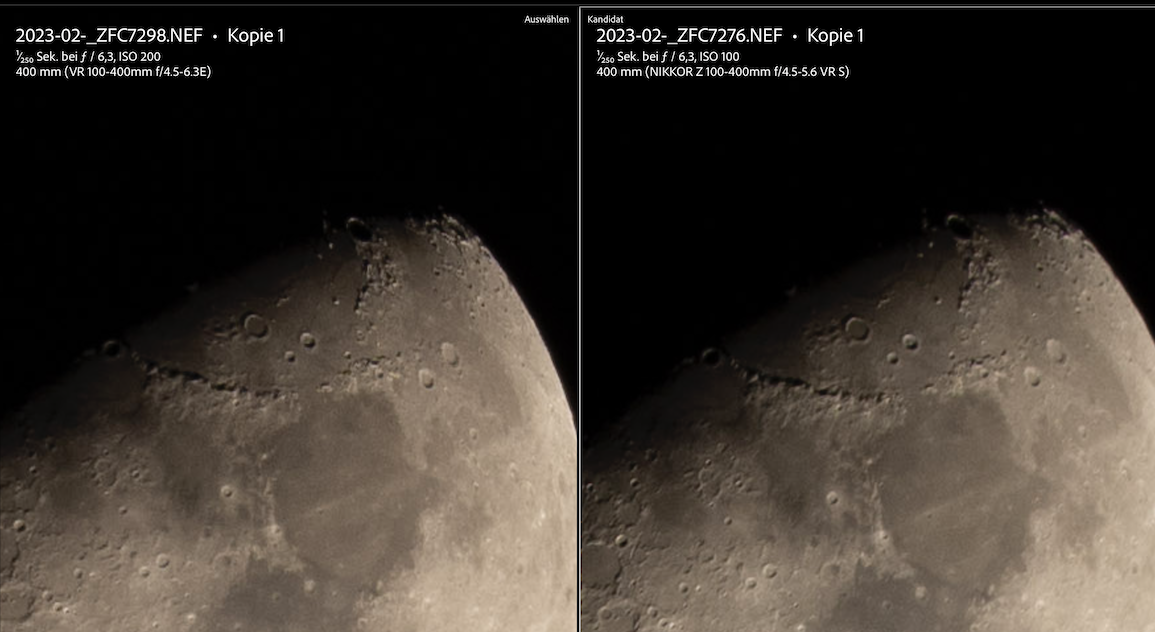

Mid-range (about 100m)
This barn door shows a beautiful wood grain and many small details. Again, here are 400% crops for comparison, so that differences can be seen at all. This time shot from a tripod with a self-timer.
Overview:

400% (open aperture)
Not that much of a difference. I focussed with the „PinPoint AF“ to the middle of the barn door.
The Tamron seems to be slightly sharper, though.
However, one thing is noticeable: the images from the Z are slightly darker. (actually, 1/60s f/6.3 and 1/90s f/5.6 should be exposed almost identically. In the image below, I added +⅓ EV to the Z on the right. Especially in the dark structures of the wood, you can see that the image has more contrast, but this also causes fine structures in the wood to be lost.

slightly closed to f/6.7, I can’t see any differences.

In the wood texture, I find the Tamron to be slightly stronger, while the Z is better at the red socket.
At 300mm:
At 300mm, the Z is sharper and has better contrast. However, this is not a huge difference…


Close-up
For this, I illuminated and photographed a €5 bill. The shots were taken from the following distances:
100mm 1.5m
200mm 2.9m
300mm 4.3m
400mm 5.7m
500-600mm 7m
(The Traumflieger test setup was used as a reference.)
100mm
The Nikkor Z is stronger here (sharper and with higher contrast).
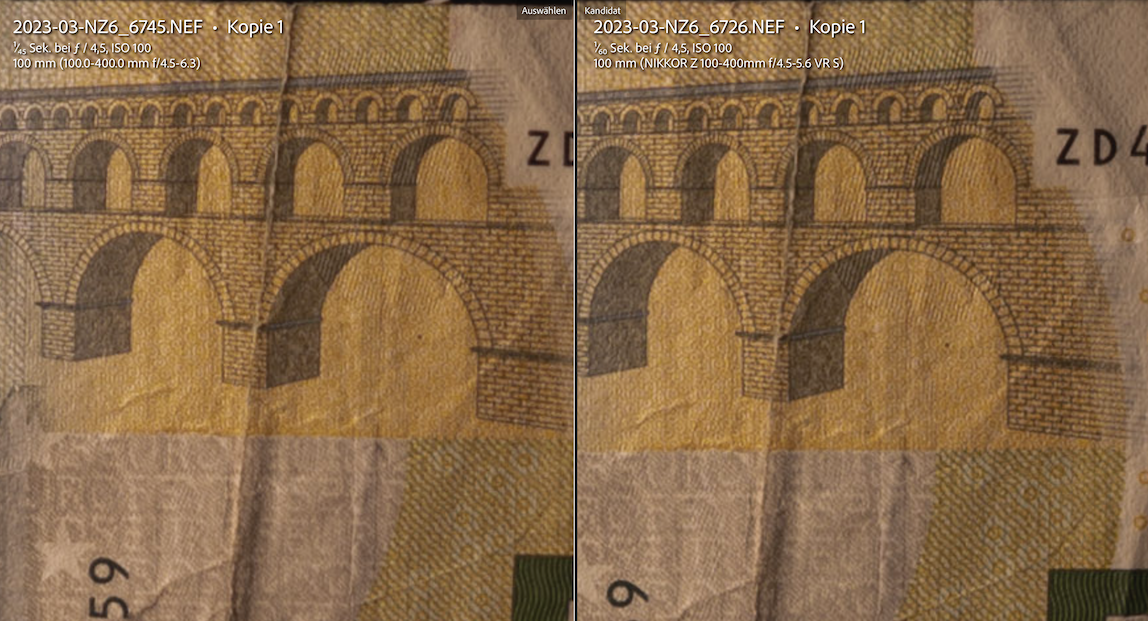

for a comparison, the Z MC105mm and the Z24-120 S from the same distance with a similar aperture.

200mm
At 200mm both seem equal, the Tamron might be a little sharper.
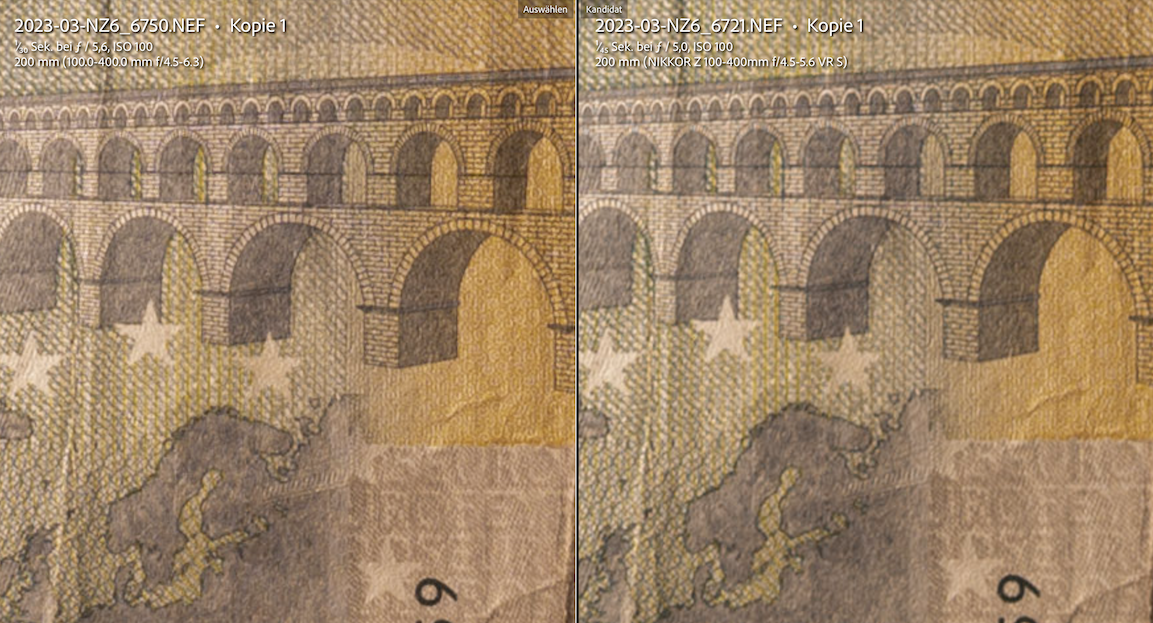
300mm
Advantages for the Z at 300mm

Here’s another bonus comparison: on the left is the Nikkor AF-S 300mm PF with the TC14E (420mm) and on the right is the AF-S 200-500mm. Here, I see the 200-500mm as superior to both 100-400mm lenses.

400mm
Both seem to be similar, still a little better on the Tamron.
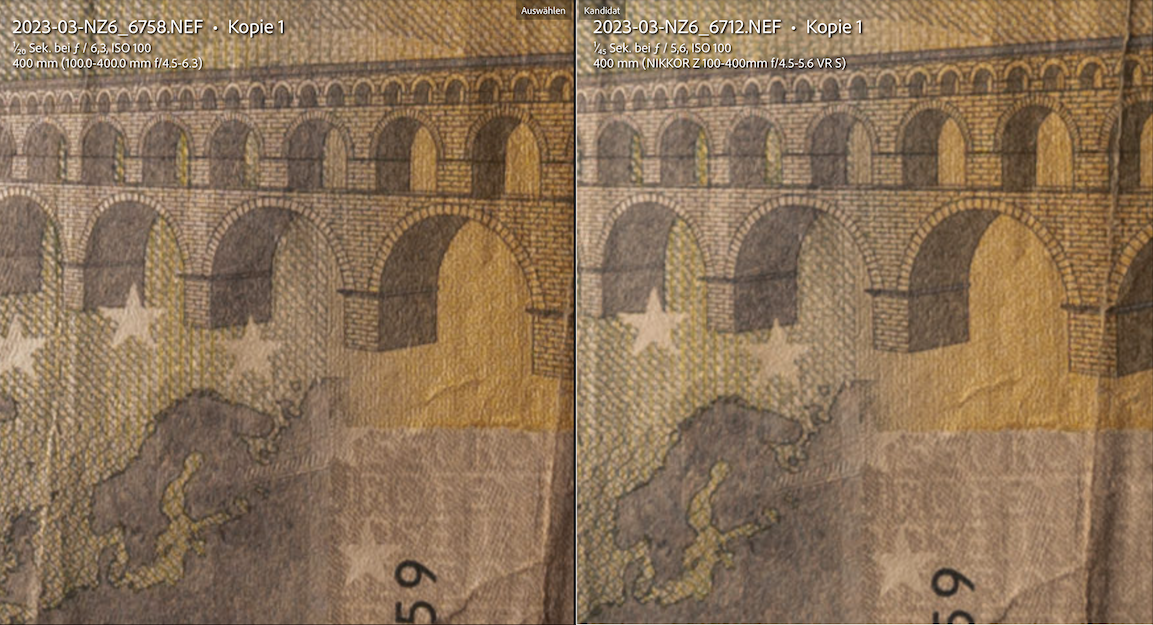
Here is the comparison between the Nikkor Z100-400 and the AF-S 200-500 at 400mm f/5.6, where the 200-500 clearly outperforms the Nikkor.

[Update] Some birds
Today I took some shots of some goose („Nilgans“, Alopochen aegyptiaca)
Overview, so you can see the distance (all shots at 400mm):

Scene above at 400% crop

and at a whopping 800% Crop in Lightroom:

[Update] Lone tree
And a lonely tree, also at 400mm (distance might be 1000m)

CloseUp
Here some flower pictures from today, both taken handheld at 400mm and at the respective minimum focusing distance. As you can see, the Nikkor gets much closer and provides a larger magnification. (No 400% crops here, just 66% crops for all of them).
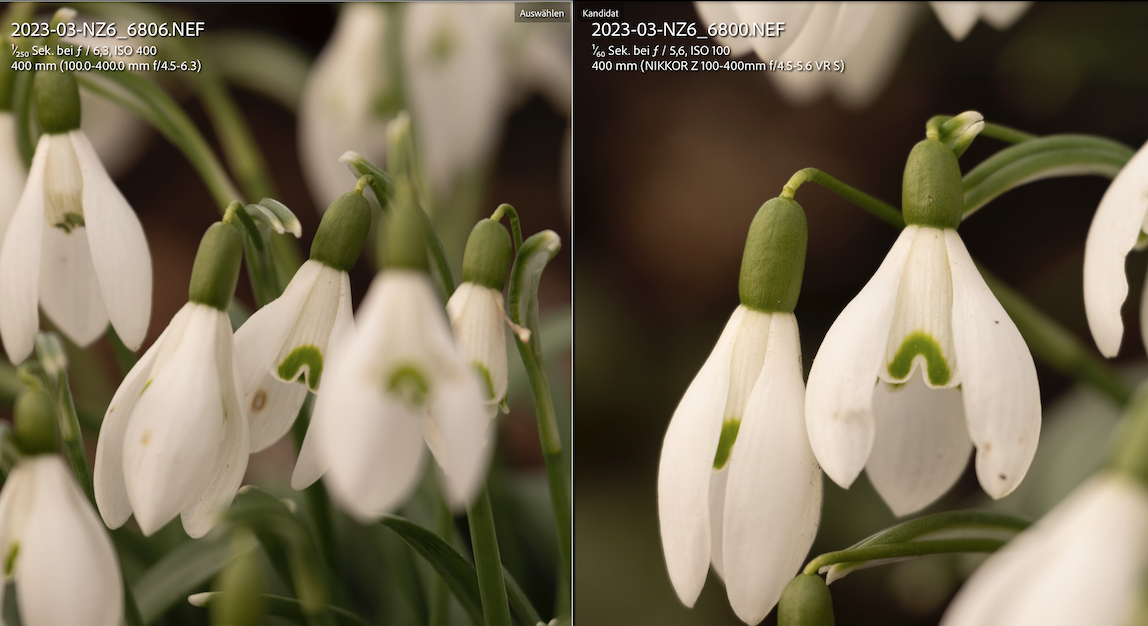
Here for comparison, the Z 105mm MC (the latter NOT at close focusing distance) and the Z24-120mm f/4 (which has a very similar magnification ratio as the Z 100-400).

[Update] Vignette, Flaring, CA, Bokeh
I skipped most of the above aspects. Vignetting is usually not important to me, as I almost always add it in post-processing anyway. I did not test flaring and bokeh. As for CA on contrast edges, both lenses seem to have no problems.
as seen at 400%:


Bokeh
Also no big difference…
Distance 3m
Overview at 165mm

zoomed in the picture above:

Simiar at 400mm from the identical position – perhaps a tad smoother on the Z (right)

Conclusion and summary
Both are great and useful lenses. The Nikkor Z 100-400 S scores with great haptics, a versatile feature set (display, control ring, coating, FN buttons), better autofocus, teleconverter compatibility, higher maximum aperture, better „pseudo-macro“ ability, better coating, better weather sealing and better stabilizer. It can be paired perfectly with the Z24-120mm (and also the Z20mm) – all having the same 77mm filter thread.
Many good points.
The Tamron, on the other hand, scores significantly with its price of about 1/4 of the Nikkor (even less when buying used), and it is 120g lighter and more compact (noticeably slimmer, albeit just under 1cm longer). Using the FTZ adapter for multiple lenses can also save weight and packing space. Thanks to its F-mount, the Tamron can also be used on older cameras or adapted to other mirrorless systems.
Optically, however, it is not quite as clear-cut. The Z is better at 100mm and 300mm, but at 200mm and 400mm, the differences are minimal and tend to favor the Tamron, which I did not expect at all. How it performs on higher-resolution sensors (Z7, Z9) remains to be seen. On the other hand, this is roughly equivalent to the sensor resolution of the Z50/Z fc – and even there, the Tamron performed well (moon shots).
As a sports and action photographer, and perhaps also as a wildlife photographer, I would lean towards the Z100-400. However, for intimate landscapes, trees, seascapes, landscape details, etc., there is not as much to justify the immense price difference in favor of the Z.













